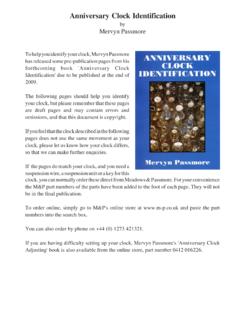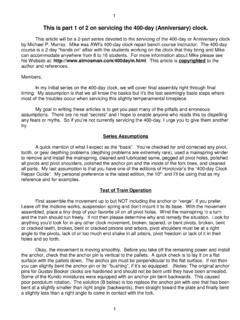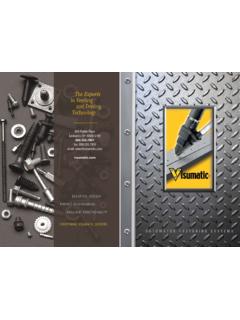Transcription of Equipment - wooden clocks
1 Equipment The following Equipment is desirable: CNC Router or Laser or Waterjet and if not one of these then a Scrollsaw or a Bandsaw. Small Lathe, this is not absolutely essential but it would make making the clock a lot easier for all of the round parts that are needed. Small Milling machine or Pedestal Drill with work holding vice. There are a lot of holes to be drilled and cleaned up after CNC machining and fabrication so the drill is pretty much essential. It may be possible to get away with an ordinary electric drill in a stand but a work holding vice is still necessary.
2 Drill Bits in the following sizes, 2mm, , and , 4 Router Cutters 2, 3 and possibly 6 for cutting out the larger frames. Hand tools; all the normal things that are used in the workshop, Files, screwdrivers, hammer, pliers etc. If you want to save a lot of time, then look at a Sanding disk and a Drum sander but these are really nice to have. Consumables Sand paper in various grades from rough to fine Danish oil for finishing. Gorilla Glue PVA Dry Film Lubricant in a spray can for the gears after everything is finished. MATERIALS For all the wooden Parts The choice of material to build the clocks from is a very personal one and is really down to you to decide.
3 I personally prefer to use actual timber, Cherry for the frames and Maple for the gears and other parts. I use timber machined to a standard size of 125mm x 6 mm and 125 x 12mm and these are fabricated into blanks for the larger components by gluing two strips together. You can however use a quality grade of plywood (Marine Ply) this route is a lot quicker as you can layout multiple parts on a sheet and have the whole thing cut out in a day, still need to put in the time cleaning up the parts and making all the other bits, but generally speaking the whole thing can be done a lot thicker.
4 I wouldn't recommend MDF unless you are laser cutting, as the parts can be easily damaged. If you use a laser however the burnt finish is actually carbon and will act as a lubricant. You can also use Perspex with which you can create some quite colourful clocks (see clock 19). Also you can of course use Brass or Steel or even Aluminium but this latter would need some post treatment to stop the wear that can happen between two aluminium parts in rubbing contact. Whatever you use, the flat 2D parts are all laid out for you on the Profile cuts sheet, this comes as a DXF file that is 1200mm square, you can manipulate this in your own CAD program, which you will probably need to do, to be able to feed the files into your CAM program.
5 For all the other parts 2 Drill Rod or Silver Steel 660 mm Long for all the shafts and numerous pins. 3 mm Rod or Silver Steel 150 mm Long 4mm" Nuts, Bolts and washers for holding the Pallets into the Escapement Woodscrews 2 required Note these are the minimum amounts of material necessary to build the clock I used more in the prototype and you may well be advised to by extra to cover those accidental losses that occur. If I have missed anything here, you will find them in the parts list for the clock anyway. HINTS AND TIPS When fitting the gear sub-assemblies into the frame make sure the mating gears engage and run smoothly.
6 The faces of mating gears should be aligned so they fully engage with each other, the front faces of the gears are lined up. There is some clearance built into the design so that when the gears are enclosed between Front and Back frames they are free to move without rubbing on the frames. Before fitting the Front Frame ensure that the dots on the front face of the gears are lined up with their mating Pinion, otherwise the gears will lock up at some point, remember these are non-circular gears and must be lined up correctly. The Pendulum and the Escapement both hang from the same pivot.
7 The Escapement and the Pendulum can be a tight fit on the pivot pin, but the Pivot pin must be free to move in the two Hanger parts that support it, this fit should not be too loose so a hole should be used as a maximum. Where it passes through the Back frame a 3 should be used. The Pendulum Bob needs to be fitted so that the centre of the Bob is approximately 250mm from the pivot point. This should allow the pendulum to swing a complete cycle every 1 second. The pendulum swing can be adjusted to make the clock run faster or slower by moving the Bob up to speed it up and down to make it run slower.
8 The Drum parts on the Drive shaft are not held tight by a wedge so will need to be glued into position. The dial on this clock was painted with white emulsion and a coat of Danish oil before cutting. The numerals were cut using a 'V' bit cutter in Artcam Express which gives a good clean-cut edge and very fine detail without having to use extremely small diameter cutter. The letters were then painted in the darker colour and any over painting easily rubbed off due to the earlier application of Danish oil. The chamfer around the outer and inner edges was done with the same V bit cutter following along the profiles mm deep.
9 The slots to hold the mating parts are all drawn with a gap of clearance all round, this generally speaking will give the correct tight fit needed for assembly. You will still need to have a small file to hand so that you can adjust any parts that won t fit. If the wood that you are using is undersize in its thickness, then unless this is excessive then it shouldn t be a problem, and any parts that are excessively loose can be glued. Any variation in the thickness of the 6mm material used, may make the Wedges a loose fit, in this case you will have to make slightly thicker ones, the ones I have drawn are slightly thick so as to account for a small amount of variation in material thickness and may need to be files or linished to make them a correct tight fit.
10 To support the weight. The Rod used for this could be Drill rod or welding rod or even nails have been used during prototype testing. I don t drill the 2 holes in the back of the Dial on the CNC, instead I temporally fix the Dial to the Front Frame with clamps or double sided tape. After measuring and adjusting its position relative to the Shaft 1 centre hole, and then drill with a hand drill from the back through the pivot holes, being careful not to drill right through the Dial. Finishing the wooden gears, I use a 50/50 solution of Danish oil and white spirits, a single coat with sanding of the teeth with fin grit sand paper before and after.










